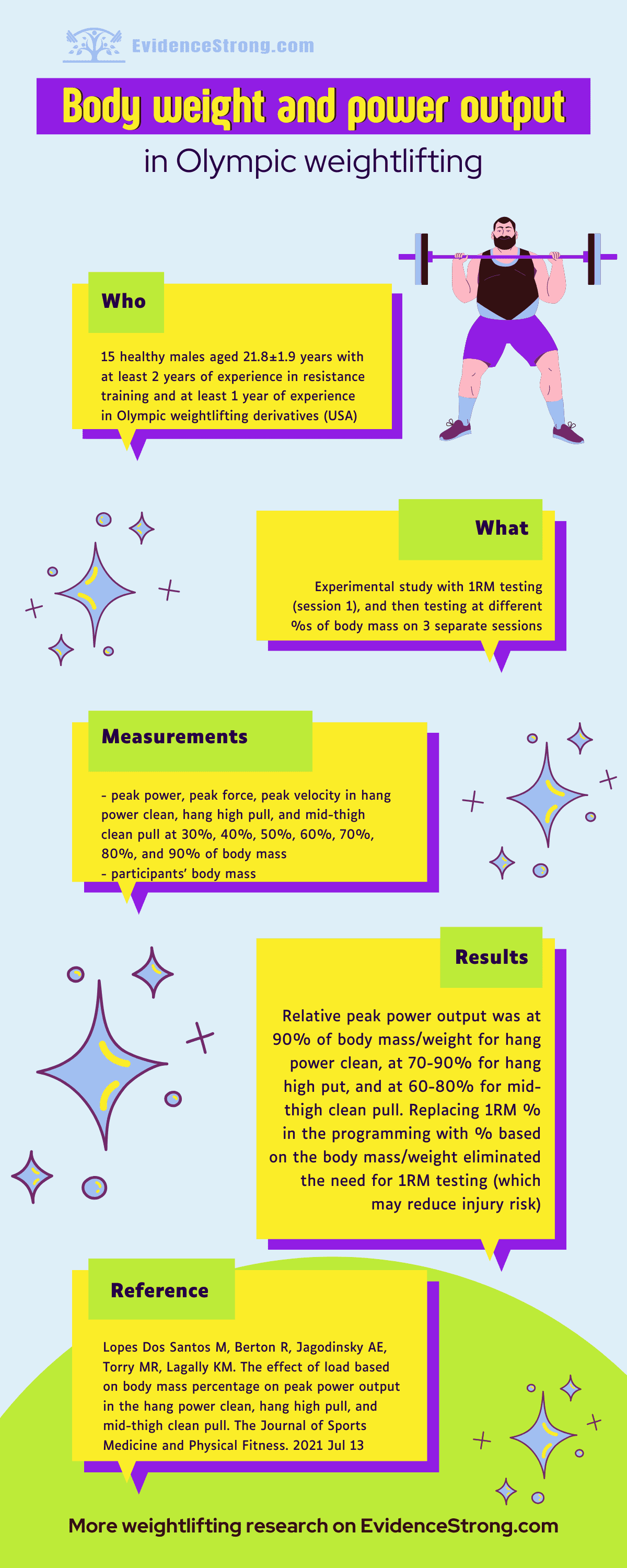Summary of an article on the influence of relative body weight load on peak power output in Olympic weightlifting.
Who
15 healthy males aged 21.8±1.9 years with at least 2 years of experience in resistance training and at least 1 year of experience in Olympic weightlifting derivatives; training times per week (USA).
Design
Experimental study with 1RM testing (session 1), and then testing at different %s of body mass on 3 separate sessions (sessions 2-4).
Outcome measures
- peak power, peak force, peak velocity in hang power clean, hang high pull, and mid-thigh clean pull at 30%, 40%, 50%, 60%, 70%, 80%, 90% of body mass
- participants’ body mass
relative peak power – peak (the highest) power (power = work exerted / time it took) at the load equal to % of the lifter's body mass
relative peak force – peak (the highest) force (force = mass * acceleration) at the load equal to % of the lifter's body mass
relative peak velocity – peak (the highest) velocity (velocity = distance / time it took) at the load equal to % of the lifter's body mass
Main results
- Hang power clean
- relative peak power and relative peak force occurred at 90% of body mass
- relative peak power and relative peak force at 90% was statistically significantly greater than at 70%, 60%, 50%, 40%, and 30%, but not 80%
- relative peak velocity occurred at 90% of body mass
- relative peak velocity at 90% was statistically significantly greater than at 60%, 50%, 40%, and 30% but not at 70% and 80%
Hang high pull
- relative peak power occurred at 90% of body mass
- relative peak power at 90% was statistically significantly greater than at 40%, and 30%, but not 80%, 70%, 60%, and 50%.
- relative peak force occurred at 90% of body mass
- relative peak force at 90% was statistically significantly greater than at 60%, 50%, 40%, and 30%, but not 80% and 70%
- relative peak velocity occurred at 70% of body mass and it was NOT statistically significantly greater than at any other load.
Mid-thigh clean pull
- relative peak power occurred at 80% of body mass
- relative peak power at 80% was statistically significantly greater than at 30%, but not 90%, 70%, 60%, 50% and 40%.
- relative peak force occurred at 90% of body mass
- relative peak force at 90% was statistically significantly greater than at 50%, 40%, and 30%, but not 80%, 70%, and 60%
- relative peak velocity occurred at 30% of body mass
- relative peak velocity at 30% was statistically significantly greater than at 90% only
Take home message
Original article
Lopes Dos Santos M, Berton R, Jagodinsky AE, Torry MR, Lagally KM. The effect of load based on body mass percentage on peak power output in the hang power clean, hang high pull, and mid-thigh clean pull. The Journal of Sports Medicine and Physical Fitness. 2021 Jul 13.
You might want to read next
Fat loss for resistance-trained athletes. What is effective?
